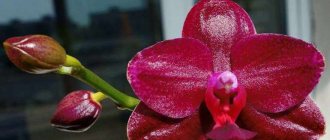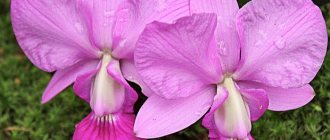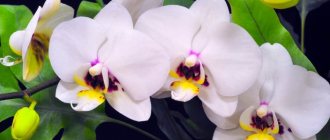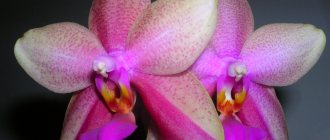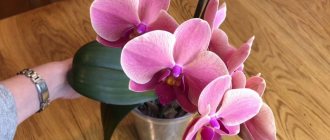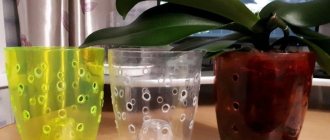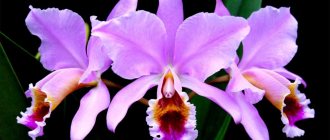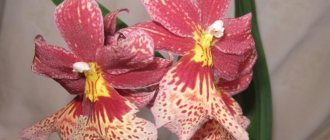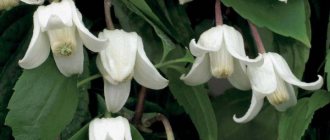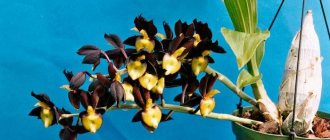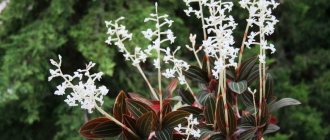Orchids take root well indoors. Pictures and photographs of such indoor plants can be found in most publications devoted to indoor floriculture. The most commonly grown orchids at home are those belonging to the Phalaenopsis white species. They are characterized by fairly high unpretentiousness and can be easily grown even by novice gardeners.
White color is always relevant, but in recent years the popularity of other colors of indoor flowers has been growing. Quite often you can see “Phalaenopsis white” and “Phalaenopsis purple” in photographs and pictures. This unusual purple orchid is increasingly appearing on the windowsills of flower growers in our country.
General information
“Phalaenopsis violet” is known to many under the name “Phalaenopsis violation”. The name of the houseplant comes from the Latin "Phalaenopsis violacea" . Photos of this epiphytic herbaceous plant of the orchid family fascinate with their beauty. “Phalaenopsis violet” has an unusual color, but does not have an established Russian name. In Russian-language sources, the indoor plant of this species is most often called the purple orchid; flower growers also use the scientific name.
A feature of the species status is the inaccurate knowledge of the origin of this plant. Many believe that the purple Phalaenopsis is a natural variation of Phalaenopsis bellina. Other authors describe the similarity in the photo with “Phalaenopsis violacea”. A miniature version of a monopodial deciduous epiphyte can be clearly seen in the photograph. The plant has a solid peduncle that can bend in a zigzag manner and bear a small number of flowers.
The flowers of the plant are characterized by a waxy appearance and have a pleasant, pronounced aroma that can be compared with the smell of water lilies, as well as freesia or bergamot. The diameter of the flowers does not exceed 6 cm. The petal part of the flowers is clearly visible in the photograph of “Phalaenopsis violet” and has an elliptical or oval-elliptical shape. The flowering plant is quite common throughout the year, and the mass flowering stage begins in spring and continues until autumn . A variety of color options are presented in the photographs of this plant.
"Phalaenopsis violet" has fleshy, elliptical or oblong-elliptical, sharp or blunt leaves. Mature plants have powerful leaves, the length of which can exceed 25 cm and the width reaches 12 cm.
Characteristics of purple orchids
At home, the purple orchid flower takes root very well. True, experienced gardeners claim that the plant is very capricious. But if you provide proper care, it will delight you with long and beautiful flowering. Photographs of this plant can be found in many publications devoted to floriculture. The range of species is very wide. At the moment there are over 30,000. The shape and shade are very different. Some look like butterflies, swans, and lizards. The color palette is wide. For example, there is a dark purple orchid, white, lilac. There may be specks and dots of a different tone.
Varieties and description
In our country, it is practiced to grow several types of orchids with a purple color. Just like the white orchid, this type of indoor plant has its admirers. Of course, white flowers are more popular among gardeners, but purple orchids are also quite common not only in photographs, but also in flower pots.
Violet orchid "Vanda"
The tall indoor plant can reach a height of more than 1 m and has very powerful, drooping greenish-gray roots. Such a root system absorbs moisture from air masses, which is a characteristic feature of any vandian orchids. The axils of the belt-shaped leaves have about four peduncles, on which no more than 15 flower buds are formed. The purple flowers themselves are quite large and fragrant.
Purple orchid "Phalaenopsis"
The houseplant's name means "moth-like." Under natural conditions, growth occurs on tree trunks. When grown indoors, the plant requires a special microclimate, which should be created artificially. "Phalaenopsis" has green aerial roots that participate in the process of photosynthesis. Such a root system needs high-quality aeration. The leaves are collected in a rosette on the lower stem part. Flowering of "Phalaenopsis" is long and can last six months.
Purple orchid "Dendrobium"
A very compact indoor plant. Some species of this plant have the ability to shed leaves once a year. Carrying out activities to care for Dendrobium is quite difficult. This type of orchid does not tolerate drafts or direct sunlight very well. Purple orchids of the Dendrobium species require additional fertilizing using nitrogen and phosphorus-potassium fertilizers. In addition, it is necessary to maintain a special temperature, humidity, and daylight hours.
How to care for varieties
Caring for the Purple Orchid at home has its own nuances. Each variety separately requires individual care in some respects.
Wanda
Air temperature directly affects the plant's immune system. The temperature must be constantly maintained at the same level of +25 degrees. If the temperature drops by 5 degrees over the course of a week, the orchid can become stressed and get sick. Air humidity should be at least 60% and not drop. Watering and spraying the flower should be done in the morning with soft water at room temperature.
Phalaenopsis
The suitable temperature for the Violet orchid is considered to be +28 degrees during the day and +17 at night. The flower must be protected from direct burning rays of the sun. But the plant accepts diffused light and partial shade very well. The phalaenopsis orchid should be watered once every 7-10 days, and the humidity level should be maintained at at least 40%. The flower needs constant ventilation and is afraid of drafts.
Dendrobium
Unlike others, this variety can grow well at lower temperatures. The optimal daytime temperature for Dendrobium will be +25 degrees. It is not afraid of significant temperature drops and retains its varietal qualities at +10 degrees. But still, you should not allow sudden changes in temperature. The flower prefers high air humidity, the level of which should be 60%. In the summer season, the plant needs to be sprayed, but stagnation of water should not be allowed to form in the leaf axils, otherwise they will begin to rot. Water for spraying should be soft.
Dendrobium is afraid of drafts, but needs constant ventilation, and does not tolerate direct rays of the sun. It is recommended to keep a plant next to it, which will serve as a support for the roots of the plant.
Features of cultivation
Blooming purple orchids in an indoor pot are a worthy interior decoration. However, it should be remembered that such a houseplant requires proper care and special growing conditions. The biggest feature of keeping the plant is represented by the absence of the need to use soil soil.
To give the plant stability, special pots or glass containers should be filled with a substrate based on tree bark. It is necessary to take into account the fact that these plants love light, but react poorly to bright sun. In addition, it is extremely important to maintain high levels of air humidity, as well as observe special temperature indicators day and night.
Transplantation and propagation
The process of transplanting a plant is carried out similarly to the initial planting. You just need to do this every 2-3 years, and the new pot should be 2-3 cm in diameter larger than the previous one.
As for reproduction, there are several ways:
- seeds, this method is very labor-intensive. You will have to wait several years before the first flowering;
- cuttings from a peduncle, high efficiency;
- dividing a bush by cutting it into two parts.
Today, the purple orchid is often grown by florists in apartment conditions. She should be provided with all the optimal conditions for flowering, good growth and the development of strong immunity to most diseases.
5/5 — (1 vote)
Features of care
This type of orchid, like the purple one, grows and blooms well in partial shade. What is important for the plant is not very hot, but rather warm temperature in the room. It is imperative to arrange sufficient ventilation of the room with atmospheric humidity at 40%.
At lower air humidity parameters, the plant may experience leaf lethargy and flowers falling off. Abundant and frequent spraying provokes rotting of the plant. Excessive watering, as well as high humidity in the air, can also stimulate rotting. Purple orchids need to be fed no more than once a month. Immediately after flowering, already drying flower stalks must be cut off.
Watering is carried out after the planting substrate has completely dried or if the presence of moisture is not observed on the inner walls of the flowerpot. determine the need for watering by coloring the root system, which becomes lighter.
We also invite you to learn about the features of growing white orchids.
Diseases and pests
Orchid is one of the flowers that are quite susceptible to diseases and pest attacks. Non-communicable diseases appear due to excessive or improper care, which is expressed in the following points:
- burning foliage and flowers with direct sunlight;
- excessive amounts of moisture;
- low air temperature in the room, which entails freezing of the flora;
- low lighting;
- steaming, which leads to wilting.
They cause weakness of the plant, which subsequently leads to death. Phalaenopsis is often affected by bacterial spot, rot, viruses, anthracnose, and fusarium. Trimming the affected foliage and spraying with medications can save the orchid from such infections.
The plant can also be attacked by the following parasites: centipede, woodlice, earthworm, ant, thrips, snail, cockroach, mite, scale insect, whitefly, aphid, nematode.
For prevention, after purchasing an orchid, it is worth carrying out a thorough inspection of it for the presence of pests; if there are any, you should immediately spray it with special preparations.
How to replant orchids (video)
The best time for replanting is considered to be the period of early spring, immediately before the growth of the indoor plant and the growth of new roots. It is not recommended to replant an indoor orchid that has already produced a flower shoot. Violation of this rule causes a slowdown in the development of the peduncle and the dropping of flower buds that have not yet opened.
What species and groups of purple orchids exist today?
A large assortment of purple orchids is presented. The following groups of purple orchids are distinguished: phalaenopsis, vanda, dendrobium, cattleya. Of course, this is not a complete list.
But these types are the most popular. Most often, varieties that belong to the phalaenopsis family are grown on the window sills of city apartments. There are white and purple phalaenopsis. Both plants are characterized by unpretentiousness and ease of cultivation. Therefore, even a novice florist can cope with cultivation. But it’s not worth dwelling only on this type because of the ease of its cultivation. With the right approach, it is quite possible to grow a beautiful flower that also belongs to other varieties. To make it easier for a beginner to choose the right type of flower, it will be useful to study the types of purple orchids as the most relevant at the moment. Therefore, it makes sense to consider each group in more detail.
Purple phalaenopsis orchid
The purple phalaenopsis orchid is considered the most common hybrid form.
The plant is characterized by a solid peduncle. It can bend in a zigzag manner. The number of flowers is insignificant. The flower has an oval-elliptical or elliptical shape. It has a distinct, pleasant aroma. The crop can bloom throughout the year. More abundant flowering is observed from spring to autumn. The leaves are very powerful, their length is over 25 centimeters, width - 12 centimeters. The culture can withstand temperatures up to +40 degrees. There is no pronounced period of rest. The plant does not need frequent irrigation: watering once a week is enough.
White phalaenopsis looks very attractive. This orchid is white with purple spots and inclusions. Sometimes there are pink splashes. Blue phalaenopsis is also found. Its petals have a uniform deep blue color. Blue phalaenopsis also looks very bright. The color is expressive. There is a barely noticeable white border along the edge of the flower. Purple phalaenopsis come in a wide range of colors, ranging from mauve to dark purple.
The yellow orchid with a purple hue has won the hearts of many. Bright and deep color, unique appearance, incredibly long flowering period - all these qualities are highly valued by domestic flower growers.
Some specimens are painted in one color. Others have fancy designs. For example, stripes, spots or dots. The purple orchid with a white spot looks very attractive.
The most striking representatives of purple phalaenopsis are:
- Schiller.
- Luddemann.
- Pink.
- Horse.
- Elegant Debora.
- Elegant Dream Diamond.
- Spider Beauty.
- Boogie Woogie.
Purple vanda orchid
A very interesting variety in terms of content and appearance is the tall violet vanda orchid.
Capable of growing more than a meter. The root system is quite powerful and open. Absorbs moisture from the air. This is a characteristic feature of all varieties of vandaceae plants. The crop does not need soil or substrate. To grow it, choose special glass vases and flowerpots. The axils of the belt-shaped leaves have about 4 peduncles. About 15 buds are formed on them.
The flowers are purple in color. They are quite large. They emit a delicate aroma.
Below are the popular purple varieties of Vanda orchids:
- Purple Rain.
- Sandera.
- Puredelight.
- Monster.
- Gordon Dillon.
- Rothschild.
- Fuchs.
- Kultana.
Dendrobium orchid
The culture is very compact. The stem is cylindrical. Its height varies from 40 to 90 centimeters. The leaves have a lanceolate shape. The peduncle consists of 1-4 flowers, each of which reaches 8 centimeters in diameter. There are different colors: orange, lilac, white, yellow. A white orchid with a purple center looks very beautiful, as well as three-color options. The culture has the peculiarity of shedding leaves once a year. Caring for this variety of orchids is quite difficult. It is necessary to maintain a certain humidity, temperature, and apply special fertilizers.
Purple Cattleya Orchid
This purple orchid in a pot looks very impressive. The flowers are large and fragrant. The shade can vary from bright red to dark purple. Homogeneous variants are extremely rare. The plant is capricious in care. Therefore, it is better for experienced flower growers to choose it.
The most common varieties of cuttels are:
- Big lips.
- Triana.
- Eclipse.
- Margaret Degenhardt Saturn.
- Bowring.
- Miyuki Little King.
- Skinner.
- Ekland.
Conclusions about purple orchids
Thus, purple orchids are very popular among gardeners. The range of such plants is quite wide. Varieties differ in the shape of the flower and its color, for example, there is a blue-violet, violet-white, yellow-violet orchid. There are also three-color options. The saturation of monochromatic varieties can vary greatly. The crop is not difficult to grow. However, you need to follow a number of care rules. Then the flower will delight you with its beauty. Check out the article about the blue orchid.
Where is this color found?
There are many purple orchid species in nature. They belong to different families. Almost all major families of orchids contain species whose flowers are purple.
It is very important that the color of the orchid is natural, as some unscrupulous sellers may specifically color the plant with ink. This can be easily noticed if there are puncture marks on the peduncle.
The purple orchid may have a hard stem, have an uneven shape and bend in different directions, producing a small number of flowers. Some types of purple orchids emit a light, pleasant aroma .
Purple orchid: varieties and growing rules
Orchids take root well indoors.
Pictures and photographs of such indoor plants can be found in most publications devoted to indoor floriculture. The most commonly grown orchids at home are those belonging to the Phalaenopsis white species. They are characterized by fairly high unpretentiousness and can be easily grown even by novice gardeners. White color is always relevant, but in recent years the popularity of other colors of indoor flowers has been growing. Quite often you can see “Phalaenopsis white” and “Phalaenopsis purple” in photographs and pictures. This unusual purple orchid is increasingly appearing on the windowsills of flower growers in our country.
Where to buy a purple orchid?
Purple orchids are sold in stores, flower shops, and markets. Most plants are hybrids. There's nothing wrong with that. Many breeders worked on developing hybrid forms. As a result, they managed to create varieties that are particularly hardy and able to quickly adapt to environmental changes. In beauty, hybrids are in no way inferior to natural varieties. On the contrary, they often amaze with their floral splendor.
Orchis Italiana (Orchis Italica)
Another variety of orchids with its own uniqueness is Orchid Italiana.
The rare, perennial plant also has a second name – “naked man”. And it is not accidental, because the remarkable thing about this variety is that at first glance you notice beautiful lilac orchid flowers, but if you take a closer look, you immediately guess the outline of a man, and his gender, including!
It can be distinguished by dark stripes on the leaves and dark spots on the trilobed lip. And enjoy flowering in March and May.
